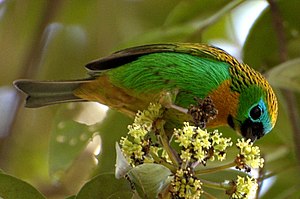Orange breasted tangar
| Orange breasted tangar | ||||||||||||
|---|---|---|---|---|---|---|---|---|---|---|---|---|

Orange breasted tangar ( Tangara desmaresti ) |
||||||||||||
| Systematics | ||||||||||||
|
||||||||||||
| Scientific name | ||||||||||||
| Tangara desmaresti | ||||||||||||
| ( Vieillot , 1819) |
The orange breasted tangar ( Tangara desmaresti ) is a species of bird from the family of the tangar (Thraupidae) that occurs in South America .
features
The orange breast tangar reaches a body length of about 13 centimeters and a weight of 19.0 to 21.5 grams. The birds are very brightly colored and show the following plumage colors:
- Upper head and back: yellow-brown
- Forehead and eye ring: turquoise
- Beak base and throat spot: black
- Chest: orange
- Cheeks and lateral abdominal region: green
- Rump , arm and hand swing , control feathers : green-black pied or edged
- Tips of the great arm coverts and lower abdominal region: yellow.
The sexes hardly differ in color. Young birds show somewhat paler colors. Due to the very distinctive color pattern, the birds are unmistakable.
distribution and habitat
The species occurs in the eastern areas of the Brazilian states of Minas Gerais , Espírito Santo , Rio de Janeiro , São Paulo , Paraná and Santa Catarina . Orange breasted tangars prefer to inhabit moist forests and forest edges at altitudes between 800 and 1800 meters.
Way of life
The birds feed primarily on fruits, and to a lesser extent also on arthropods . They live in pairs or in small groups of up to twelve individuals, sometimes in company with other species of Tangaren. In the state of Rio de Janeiro, both sexes were observed building nests in January and February. The cup-shaped nest is primarily made from dried bamboo leaves and placed at heights between 0.5 and nine meters above the ground, preferably in the forks of trees. The eggs are whitish in color and have a few small gray spots. While the female is breeding, the male provides it with food. The incubation period is 12 to 13 days.
Hazard and protection
The orange-breasted tangar is not uncommon in protected areas and national parks and is therefore classified by the World Conservation Organization IUCN as ![]() " Least Concern = not endangered". Outside of the protected areas, however, a threat has already been identified due to the reclamation of the habitat.
" Least Concern = not endangered". Outside of the protected areas, however, a threat has already been identified due to the reclamation of the habitat.
Individual evidence
- ↑ Hilty, S. (2017 Brassy-breasted Tanager (Tangara desmaresti)). In: del Hoyo, J., Elliott, A., Sargatal, J., Christie, DA & de Juana, E. (eds.). Handbook of the Birds of the World Alive. Lynx Edicions, Barcelona. (Retrieved from http://www.hbw.com/node/61682 on February 11, 2017).
- ^ IUCN Red List
literature
- Josep del Hoyo , Andrew Elliott, David A. Christie: Handbook of the Birds of the World, Tanagers to New World Blackbirds. Volume 16, Lynx Edicions, 2011, ISBN 978-84-96553-78-1 .
Web links
- neotropical.birds - Neotropical Birds
- itis.gov - ITIS Report
- xeno-canto - spread
